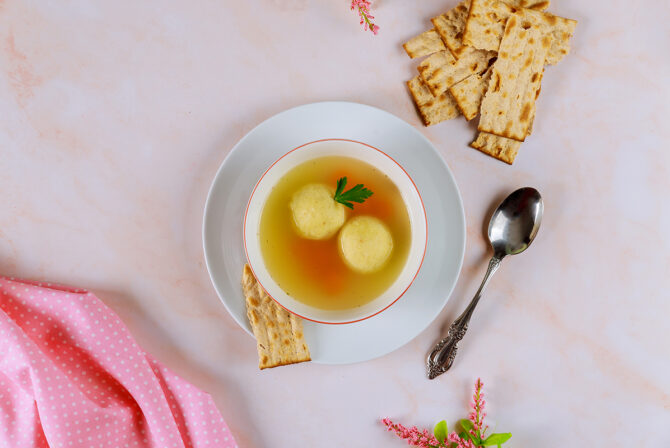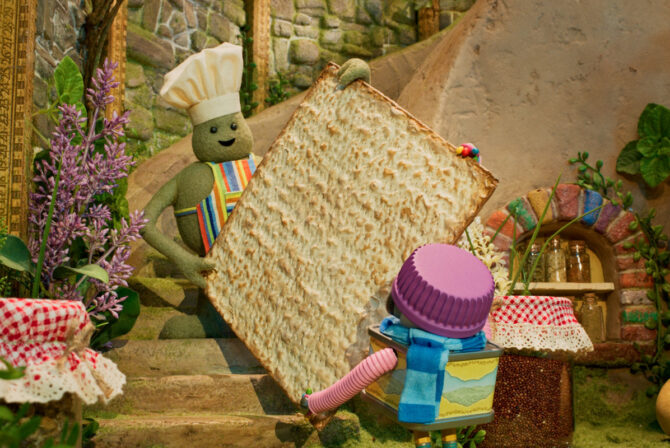Passover seders can get a little long and boring for young children, but it’s all worth it for that one shining moment: the search for the afikomen. Traditionally, the afikomen (a piece of matzah broken in half), is placed in a cloth bag and hidden somewhere in the house for the kids to find near the end of the meal. A prize is usually involved, so you can see why it’s important. You can have an even more meaningful experience by hand-making an afikomen bag with your kids.
This project is intended for the Martha Stewarts among us. If you love crafting, this one’s for you!
You Will Need:
Felt: one large piece for the envelope (11.5″ x 16″) and smaller pieces in various colors for decorating the envelope
A pencil
A ruler
Sharp scissors
Fabric puff paint, in glittering silver, sold in an applicator bottle
Acrylic paint, or fabric paint, or both ( I mixed some white acrylic paint into my purple fabric paint)
Ric rac trim or ribbon
Freezer paper
An iron
Small manicure scissors or a craft knife
A small piece of dense sponge or a stencil brush
A hot glue gun
The word “afikomen” written in English or Hebrew (provided below)
A button, snap closure, or hook and eye closure (optional)
Instructions:
1. Following the diagram provided here (right click and view image to enlarge), cut out your felt piece with sharp scissors. You can draw on the felt with a pencil and ruler. While I chose to make my envelope a horizontal one, you can certainly play around with the dimensions and make an envelope that’s square, or with the flap on the end, like a large mailing envelope.
2. Cut a piece of freezer paper to roughly 8 1/2″ x 11″ and using the word afikomen in English or Hebrew (right click and view image to enlarge) print the document onto the freezer paper, making sure that the printing will happen on the non-waxed side.
3. Using small manicure scissors, carefully cut the black letters out, and iron the stencil onto the flap of your felt envelope, or anywhere you choose. Make sure that the freezer paper is securely adhered to the felt, particularly around the letters.
4. Using a dense sponge or a stencil brush apply paint to your stencil, making sure not to overload the sponge or brush with paint. Dip sponge or brush in paint, and remove most of the paint on a piece of scrap paper before applying paint to the felt. Too much paint can cause the paint to bleed under the edges of the freezer paper.
5. Allow paint to dry, apply another coat if necessary. Many instructions for freezer paper stenciling say to wait overnight to remove the stencil, but I really don’t know why, and I certainly have never been able to wait that long!
6. Iron pieces of freezer paper to the pieces of felt you’ll be using to decorate your envelope.
7. Create felt applique pieces by getting the kids to draw small simple pictures on the freezer paper side, and then cut them out to use as decorations. The red flowers on my envelope were drawn by my daughter, and they’re inspired by the wild red poppies that cover the countyside in Israel around Passover time!
8. I didn’t include a closure on my envelope, but you certainly can sew on a button and simply cut a slit in the flap of the envelope, or sew on snaps or hook and eye closures. If you choose to do this, do it before you start laying out the felt applique pieces.
9. Create designs on two sides of your envelope using your felt pieces, and moving them around on the envelope until you’re happy with the results, and then attach them with hot glue. Add ribbon or delicate ricrac for a nice touch.
10. For the finishing design touch–lay your whole envelope piece out flat, and add small and delicate details to the Hebrew letters and some of the felt pieces with fabric puff paint. I like using the silver glitter puff paint as it looks like jewels! (This step might be difficult for small children as it requires quite a bit of finesse to squeeze the bottle just enough so that a tiny dot comes out. But some children may be quite able, just let them practice on a separate piece first. Also, be very careful not to touch the dots that have been applied, as they’ll smear.)
11. Set aside to dry overnight (or a full day) as the fabric puff paint takes a while to dry.
12. Glue the envelope closed with a line of hot glue on each of the side seams. Since it’s hard to make a totally straight seam with hot glue, it looks much better to leave the edges on the outside.
13. Enjoy using at your Passover seder for many years to come!







